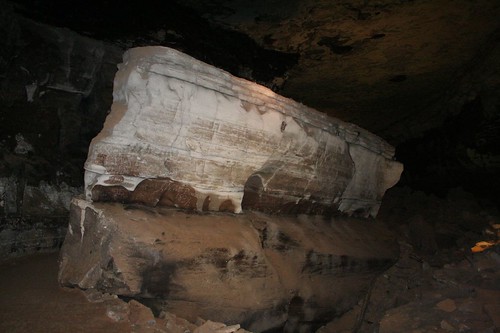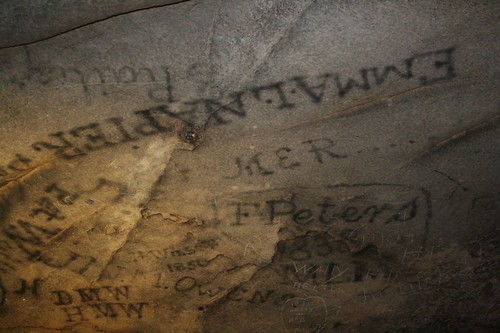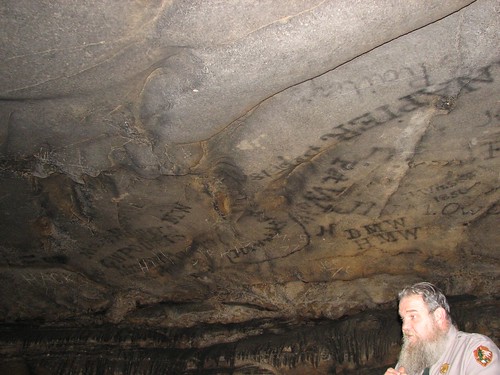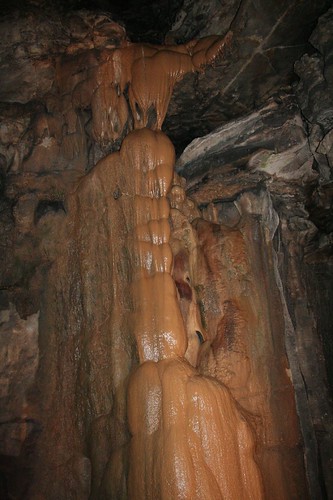When we arrived at Mammoth Cave, it was dark but not too cold, so we set up camp and hung out for a while. At one point, we saw our mouse running around under the car. We didn’t see him jump back inside, so we hoped against hope that he’d run away. Nevertheless, we baited and set our mouse traps – three of them, in two different varieties, to be sure we caught him. Then we went to bed.
We got up in the morning and checked the car. First trap: No bait, no mouse. Second trap: Same story. Cunning little mouse – he’d gotten the bait without triggering either trap. The third trap was snapped shut, though, with a dead mouse inside. Greed and gluttony were the mouse’s downfall. Sarah laid him to rest in the garbage can at Mammoth Cave campground.
We had only done a cursory job of cleaning the car on the previous day, knowing the mouse was still running around. With the mouse gone, we now set out to clean up better. In the course of cleaning, we opened up an old suitcase that we’ve been using to store some of our clothing. Inside was something like half a gallon of a couple of different kinds of grains! The mouse was apparently building up its food cache for the winter! I don’t know how many trips he must have taken back and forth between our plastic bags of food and the suitcase to build up that kind of cache. Amazing! Does he just carry the grain in his hands? Or does he load up his mouth and then spit it out? However he does it, it seemed like an awful lot of work for one mouse. We started to worry that a small army of mice was running around our car and we’d only caught the first…
Somewhat later, we noticed something between two storage containers in the back of the car. After pulling some things out of the car, we saw that it was the mouse’s nest, consisting of a huge pile of paper towels and Kleenex with a healthy dose of mouse hair mixed in. It was probably eight inches wide and about four inches tall – a lot of work went into nest building. Since Sarah had disposed of the mouse, Brian got the job of cleaning up the nest.
Thoroughly disgusted, but feeling better about the state of the car, we drove over to the visitors center to check on times for guided cave tours. It turned out that the first tour wasn’t until 11:15, so we had some time to kill and walked out to hike some of the trails around the visitors center. After finishing up a 64-mile hike the previous day and then driving for several hours, it was good to get outside and stretch our legs out.
At one point we came to a nice overlook of the Green River:

Eventually, it was time for the tour. It turned out that our tour would be led by a park ranger with a bushy gray beard who loved to make the cave seem eerie and spooky. A cross between Santa Claus and Alfred Hitchcock, the kids on the tour loved him.
Despite the ranger’s attempt at foreboding, we proceeded with the tour and entered the cave through its natural entrance:

We were on the Historic Tour, which explores the inside of the cave for about two hours. We learned that Mammoth Cave is the longest cave in the world. Roughly 370 miles have been explored and mapped, and no one knows how many more are yet undiscovered – groups of spelunking buffs, with the park’s permission, frequently explore and chart out new areas of the cave, so the cave “grows” every year. But the cave is virtually entirely devoid of the cave formations that you see at other caves (“speleothems” is the technical term, as we had learned at Carlsbad Caverns). The limestone of the cave is covered at ground level by a “cap” of sandstone and shale, which are harder rocks that prevent water from seeping in, dripping, and oh-so-slowly building up into stalagmites and stalactites.
What the cave lacks in formations, it makes up for in history. The cave was explored by prehistoric people thousands of years ago, but around 2,000 years ago, all human record ends. Legend has it that in the late 1700s, a homesteader shot and wounded a bear and then tracked it to the entrance of the cave – thus, the cave was rediscovered.
The cave’s most important role in recorded history came during the War of 1812. Lots of bats live in the cave, and over the centuries, they deposited a lot of guano. Guano is rich in calcium nitrate, which can be converted to potassium nitrate, also known as saltpeter. Saltpeter is used to produce gunpowder, and when the British blockaded U.S. ports during the War of 1812, the U.S. war effort needed a new domestic source of saltpeter to replace imports. The source was found in Mammoth Cave, and a few smaller caves.
The beginning of the tour passes through the relics of the saltpeter mining operation. Miners built pipelines out of hollowed-out tree trunks:

Next, we came to the pulpit:

In the 1800s, this room of the cave was actually used as a church. Whether it’s a hot Kentucky summer or a cold winter, the temperature inside the cave stays in the fifties, so it made a great meeting place. Churchgoers would walk into the cave with their lanterns, and when they arrived in the church area, the lanterns would be placed on the pulpit, behind the preacher. His sermons would go on and on for hours, the ranger said, and he had a captive audience – no one could see to leave the cave without their lantern.
Although there are no cave formations, cave visitors have seen all sorts of different things when they look at the rocks in the cave. Like when you look at clouds or stars, you can let your imagination run wild. What does this look like?

When the ranger asked us, a young boy immediately said “a coffin”. The ranger said he was right, and proceeded to talk about deaths in the cave. 23 people are known to have died, and the most interesting death was a prehistoric man who was exploring the cave and had a massive five-ton boulder fall right on him and crush him. His body lay there, perfectly preserved, for almost 2000 years, until it was discovered by explorers in 1935. The Civilian Conservation Corps helped rig up some ropes and pulleys and hoist the boulder off the poor guy so he could be examined by the archaeologists.
Another part of the cave’s history is its graffiti. Once the price of saltpeter dropped after the War of 1812, the cave was repurposed as a tourist attraction, making it the second natural American wonder turned into a paid attraction, following Niagara Falls. For an extra fee, tourists could use a candle to write their names in soot on the wall or ceiling of the cave. Lest we get any ideas, the ranger informed us that writing from the 1800s is considered historical graffiti while writing from the 21st century is a federal offense.
Here’s some of the graffiti – Santa Hitchcock snuck into one of the photos:


The cave was formed by water rushing through, and in fact the cave has five distinct levels where the water ran through at various times. When water rushes through the cave, it creates scallop patterns in the roof – the slower the water, the deeper the scallops:

The water still runs on the lowest level of the cave, and it’s particularly high during the springtime. The park service used to run boat tours of the cave on this underground river, but they stopped in 1991 for various reasons, among them pressure from environmentalists. It turns out that there are creatures in the water that are perfectly adapted to the cave and don’t exist anywhere else on earth, such as eyeless fish. They evolved without any eyes, since eyes wouldn’t do them any good, and without any pigmentation, since coloring wouldn’t help them attract mates or avoid predators. If you picked one up, you could look entirely through its body at its internal organs. They have highly sensitive vibration receptors, which allow them to sense food nearby. Well, you can imagine that with a boat floating through the river, those vibration receptors would go haywire and the poor eyeless fish would get completely confused. So they stopped the tours.
Toward the end of the tour, we did see some flowstone, the only significant formation on the tour:

It was a great tour – we learned a lot and the ranger was endlessly entertaining. After the tour was over, it was about 1:30, so we jumped in the car and started the drive to Chicago to visit Brian’s family for Thanksgiving!
No comments:
Post a Comment